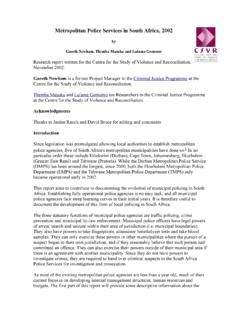Transcription of alert - SBP
1 | SBP alert | Issue Paper 1 2014 | | 1alertIssue Paper 1 2014 | An sbp occasional paper | National Development Plan (NDP) sets out several ambitious goals for the small to medium enterprise (SME) sector - including a target for 90% of employment opportunities to be created by this sector by 2030. The NDP envisions the south African economy growing by at least growth per year over the next 15 years, to treble in size and identifies the SME sector as a pivotal player in driving this growth. Yet despite government s commitment to growing and supporting the country s SMEs, these firms continue to face an extremely hostile business environment, including lack of skilled staff, burdensome regulations, tough local economic conditions, lack of finance and the high costs associated with employing NDP s targets for job creation in the SME sector depend on the creation of a business environment that supports the growth and sustainability of existing SMEs, a culture of entrepreneurship, and enables new SMEs to prosper.
2 The new Small Business Development Ministry, under the leadership of Lindiwe Zulu, has an important role to play in achieving this. The Ministry has been established to deliver dedicated and focused support for small businesses and to ensure that the common challenges that confront the sector are addressed in a co-ordinated way. Priorities for the Ministry will include addressing the legal and regulatory environment; improving access to markets, and availability of finance; addressing the skills deficit; enabling better access to information; and improving the effectiveness and reach of support institutions. If the Ministry is to address these challenges effectively, it will need to begin with a clear understanding of the diversity and complexity of the sector. Policies, incentives and support structures need to be designed on the understanding that the businesses that fall within the broad SME category differ vastly from one another in their ambitions, their potential for growth, and their stage of development.
3 The SME landscapeOne of the critical challenges facing policy makers is the dearth of information about the growth cycle and the dynamics that affect SMEs at each stage of firm development, from survivalist businesses to potential high growth entrepreneurial firms. This lack of empirical information has led to policy decisions that rely on anecdote, theory or ideology - shaky foundations at best. Assessing the potential impact of policies and regulations on small businesses requires a clear understanding of short and long term effects at sector level, and at the level of individual firms at different stages of development. A richer and more detailed analysis of the SME lifecycle therefore would enable policies to be targeted more effectively. The potential of the small firms as an engine for growth in developing countries has been widely acknowledged by global institutions such as the World Bank.
4 In south africa , SMEs are responsible for a significant level of product Examining the challenges facing small businesses in south AfricaExamining the challenges facing small businesses in south africa | SBP alert | Issue Paper 1 2014 | | 2innovation and have a geographically broad spread, providing a mechanism for wealth creation in both urban and rural areas. Yet the growth of the sector has been stagnant in recent years, and government s efforts to boost the sector over the past two decades have yielded limited results. south africa s SMEs are estimated to account for over 60% of employment, according to a 2010 Abor and Quartey report, compared to a global average of 77%. What s more, they have an exceptionally high failure rate - in May 2014, Minister of Trade and Industry Rob Davies noted that as many as 70% of the country s SMEs fail in their first year - giving us one of the highest failure rates in the world.
5 According to the 2013 GEM report only of south africa s adult population is involved in early stage entrepreneurship and another have been operating for more than three and a half years. The latter figure puts south africa in fourth last place across the entire GEM study. In contrast, around 17% of Brazilians are active in early-stage entrepreneurship and 15% operate established World Bank reports that the viability of micro-enterprises is closely linked to the motivation for starting the business successful businesses with potential for growth tend to be started by choice, as entrepreneurial ventures. Survivalist micro-enterprises, motivated by a lack of other employment options, seldom turn into successful, larger firms. For the most part, these business owners would prefer to give up their businesses and become an employee, if the opportunity arose.
6 They are not hiring, or growing their businesses. Most of south africa s SMEs fall into the latter youth unemployment bulge is now in a critical condition with around 36% of south africa s youth unable to attain employment. This presents a serious challenge to the country and could be a permanently destabilising factor if not resolved rapidly and effectively. The NDP places SMEs at the head of the employment charge, and with good reason. SBP studies show that small firms are more likely to employ young and older work seekers which make up a large percentage of the unemployed population. Worryingly, however, Stats SA s Labour Force Survey shows that smaller firms that employ less than 50 people are becoming less important as job creators. The number of people working in this business demographic has been declining since 2000.
7 These figures are in direct contrast to the international trend, which has seen SMEs accounting for a rising percentage of tape and burdensome regulationsDesigned to respond to the dearth of empirical analysis of the SME sector, SBP s SME Growth Index is a multi-year research project geared towards establishing a solid, evidence-based understanding of south africa s SMEs. The largest, most comprehensive study of the SME community ever undertaken in south africa , and one of a few of its kind worldwide, the study tracks the experiences of a panel of 500 established small firms in the manufacturing, business services and tourism sectors. The data that has been assembled over the course of the study provides an unparalleled resource for understanding the lived dynamics of south africa s its inception in 2011, SBP s SME Growth Index has repeatedly identified the regulatory burden as a critical challenge facing small businesses.
8 Frequent changes in the regulatory environment, the need to keep track of overlapping and sometimes conflicting regulatory requirements across multiple departments and levels of government, poor communication and access to information, and administrative inefficiencies in government departments and municipalities, mean that the SME owner spends a disproportionate amount of time dealing with regulatory compliance. In fact, our SME Growth Index has established that small firms spend an average of eight working days a month dealing with red tape. Every one of those days represents management time spent away from core business functions, and thus loss of income. The Davis Tax Committee Interim Report on Small Business indicates a median cost of R20 500 to comply with all tax requirements. Using the same hourly rate used in the Davis report we can estimate that the cost of regulatory compliance (75 hours a month) to SMEs equates to roughly R18 000 a month, or R216 000 a year.
9 If a company has a turnover of Examining the challenges facing small businesses in south africa | SBP alert | Issue Paper 1 2014 | | 3R5 million, these costs represent 4% of turnover. This is a staggering cost on the owner s time and clearly highlights the disincentive, and opportunity cost, for any aspiring entrepreneur endeavouring to comply with business legislation. Firms identified their top red tape headaches as: dealing with SARS, labour issues, dealing with their municipality, and compliance with BEE. Responses differed somewhat across industries tourism firms were more concerned about municipal issues, while manufacturers were more likely to struggle with labour may have the potential to be the biggest creators of jobs in the country but procedural challenges inherent in our labour system hamper their willingness to hire.
10 Indeed, red tape is further highlighted where small firms can spend up to eleven days per case at the CCMA to resolve a dispute. Furthermore, studies indicate that the average SME is taken to the CCMA twice a year. This represents a huge cost in terms of lost work days creating direct and opportunity costs for SME owners. The decline in the workforce employed by the SME sector is indicative of a corresponding decline in the total number of SMEs in the country. Indeed, the latest GEM statistics show that south africa currently has more established small businesses closing down than new SMEs being founded. Moreover, the Davis Tax Committee Interim Report indicates the declining share of SME investment in the economy - from in 2010 to in 2012. This shows a backward trend to SME activity, a trend that south africa can ill afford.








